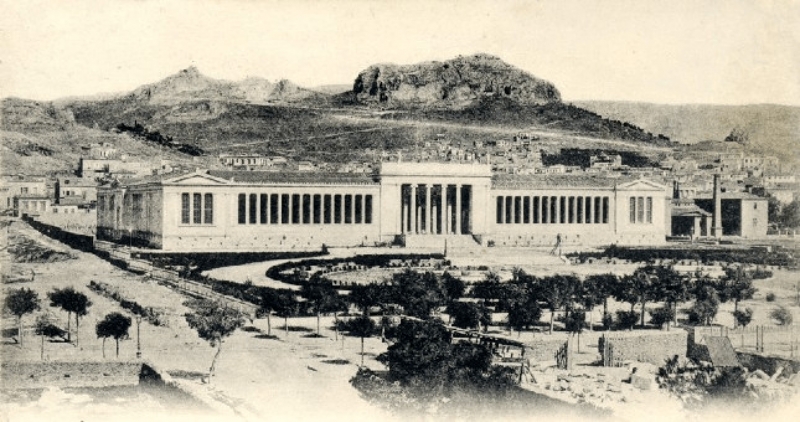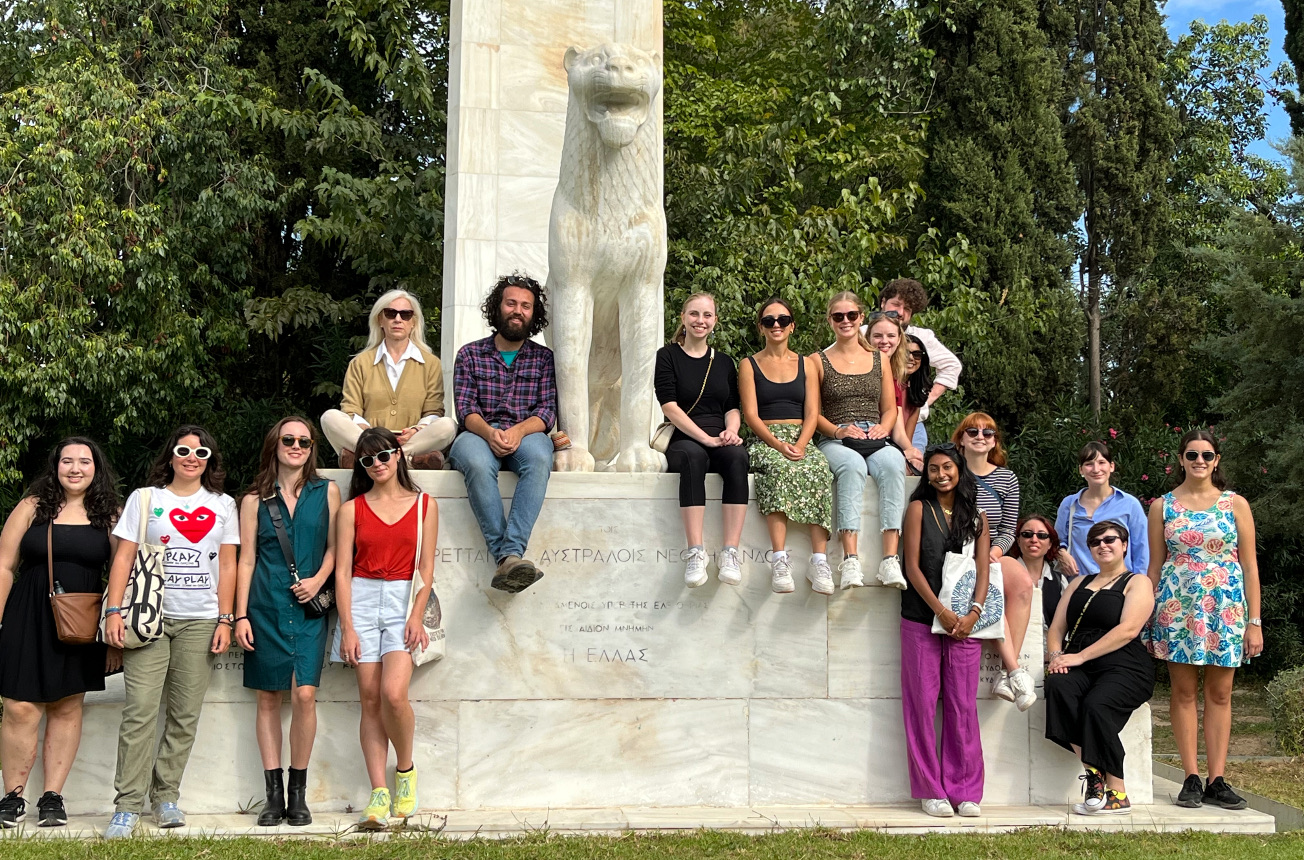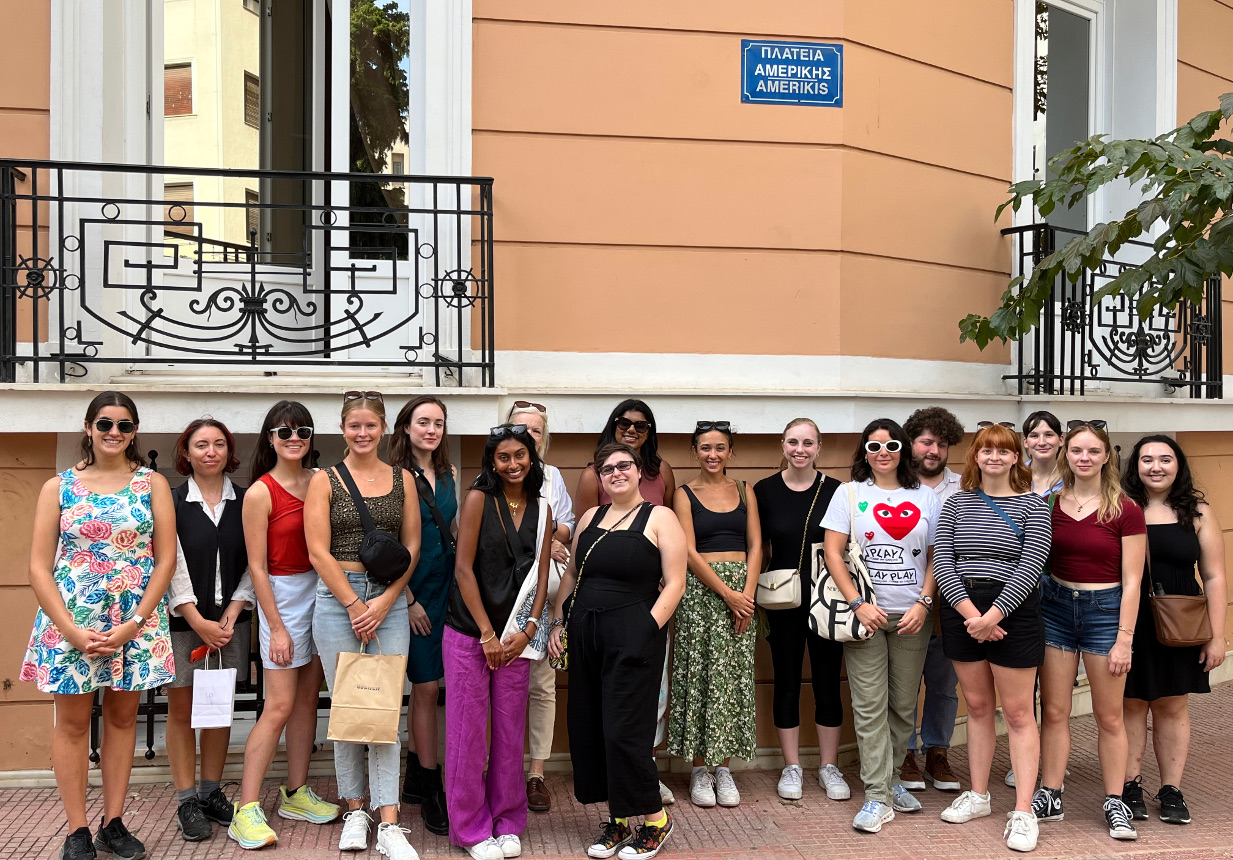There is no need to mention or to list the numerous magical and archaeological sites of Greece, all of which can be found in any visitor’s guide. Their fame is so great, and rightfully so, that at times recent historical periods, local histories and traditions, and current artistic movements seem to get overshadowed. Therefore, we aim to discover a few alternative paths that may show the cultural history of Greece in a more diverse light.
The Athens Art Walk
In 2013, the Fulbright Foundation Greece introduced a new initiative addressed to the U.S. Fulbright Fellows: the Athens Art Walk. The Athens Art Walk, which typically takes place in autumn as part of the arrival orientation, proposes a tour that takes U.S. award recipients to Greece around the City of Athens to visit some of the main sites for cultural events in the center of the Athens, to view some of the contemporary art exhibitions on display and to discover their relationship to the city and its inhabitants. Furthermore, the city has added some impressive international architectural buildings to its curriculum, showing the way forward for a society emerging from a recent crisis. There are opportunities to meet the people behind the scenes and some of the Fulbright alumni involved.
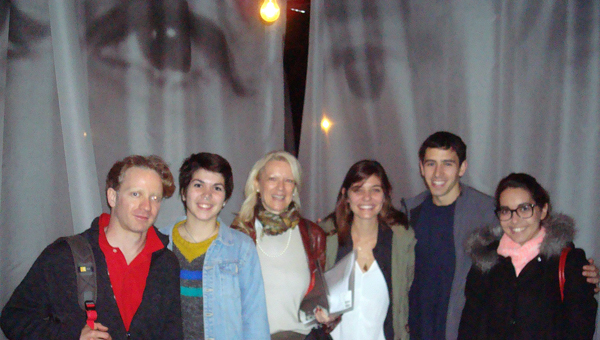
In 2013, participants were introduced to a multitude of contemporary perspectives: from young and emerging Greek artists at the National Museum of Contemporary Art to famous German contemporary artist, Martin Kippenberger at the Museum of Cycladic Art, who imagined a global underground metro system, called Metro-Net, connecting the island of Syros - where Kippenberger built the first subway entrance in 1993 - to different cities around the world (of course, the entrances did not actually lead anywhere). Then we continued via world renowned French artist, Christian Boltanski who created a portrait of the city of Athens by putting a face to its anonymous citizens at the Onassis Cultural Centre. We closed off with a personal meeting with major contemporary British artist, Adam Chodzko, who revealed his take on the architectural structure of the Benaki Museum Piraeus Street Annexe with an intervention to the building based on original research into the archive of the museum. He was pleased to welcome us to the opening night where we could listen to the artist’s talk.
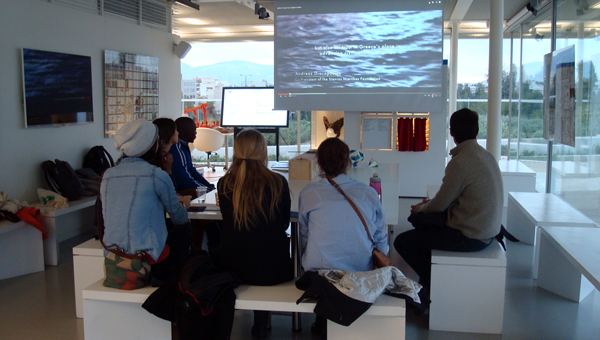
In 2014, we focused on the south axis – the main artery that runs from the city center towards the coast -, which is currently in full development. We made stops at three foundations on our way down Syngrou Avenue, three venues that exist thanks to the generous support of their founders.
PHILANTHROPY
We do not need to stress the importance of philanthropic gestures for the arts and culture – and other fields - in the United States. Rockefeller, Carnegie Mellon, Morgan, Getty, Vanderbilt ... are just a few names that immediately spring to mind. Carnegie’s Gospel spelt out in details the obligation of a great man to perform philanthropic deeds. Giving money away in your will is not good enough; it has to be dispensed with during your lifetime. “The man who dies thus rich dies disgraced,” Carnegie wrote. In Greece, the private sector has played an equally crucial role towards the development and well-being of society through education, culture, health, and prosperity. Stavros Niarchos, Eugenios Eugenidis, and Aristeidis Onassis, three giants primarily connected with the shipping world, decided to continue their legacy by offering vast funds towards the creation of foundations and institutions with these goals in mind.
The Stavros Niarchos Foundation Cultural Center
The Stavros Niarchos Foundation is one of the world’s leading private international philanthropic organizations, making grants in the areas of arts and culture, education, health and sports, and social welfare. In 2006, the Stavros Niarchos Foundation announced its plans to fund the development of the Stavros Niarchos Foundation Cultural Center (SNFCC), a project that included the construction and complete outfitting of new facilities for the National Library of Greece (NLG) and the Greek National Opera (GNO), as well as the creation of the 170,000 m² Stavros Niarchos Park. In February 2008, after a closed international architectural competition, the Stavros Niarchos Foundation’s Board of Directors announced its unanimous decision: the Renzo Piano Building Workshop. The Visitors Center designed by Greek architecture students, Spyros Giotakis and Ayis-Panayiotis Mourelatos, was a light temporary structure, which operated until the SNFCC’s completion in mid 2016. It offered the public the opportunity to visit the construction site, learn about the structure and familiarize visitors with the vision and mission of the SNFCC. Since its official opening in 2017, the SNFCC has become a meeting-point for Athenians of all ages, who like to stroll in the beautiful gardens and/or attend one of many events. You can regularly check its ongoing activities on the SNFCC website (a free shuttle bus is provided from the Syntagma Square).
W https://www.snfcc.org/en
A Esplanade, Evripidou Street, Delta Falirou
Onassis Cultural Centre
The Alexander S. Onassis Public Benefit Foundation was established in December 1975 in accordance with Aristotle Onassis' last wish to honor the memory of his son, Alexander. Culture, education, the environment, health, and social solidarity come first on the agenda of the Alexander S. Onassis Public Benefit Foundation. All projects of the Alexander S. Onassis Public Benefit Foundation relate to Greece or Greek culture and civilisation. The Onassis Cultural Centre-Athens - OCC, commonly known in Greek as the Stegi Grammaton & Technon or simply Stegi - was inaugurated in December 2010, as a new cultural site accessible to all. Its mission is the promotion of contemporary cultural expression, the support of new Greek artists, the cultivation of international collaborations, the education and lifelong learning, as well as the co-existence and interaction of sciences, innovation and arts. The building was designed by the French architectural firm Architecture Studio whereas the architectural redesign of both amphitheaters was assigned to Architect Mark Foley.
W https://www.onassis.org/onassis-stegi/
A 107-109 Syngrou Avenue
Eugenides Foundation
The Eugenides Foundation was established in 1956 as a non-profit-organization with the objective to contribute to the education of young Greeks in science and technology.
It is a grant-giving entity (scholarships, publications) and a physical Technical and Vocational Education Center that houses a library, a planetarium, exhibition spaces, an amphitheater, and lecture rooms. The building was officially opened in 1966. The new digital Planetarium (since 2003) is one of the biggest and best equipped in the world. It is worthwhile to check out their program of fascinating screenings. Recently, with the help of the U.S. embassy in Athens, a UTechLab or a digital innovation center for youth was added to the premises.
W https://www.eef.edu.gr/en
A 387 Syngrou Avenue, Paleo Faliro
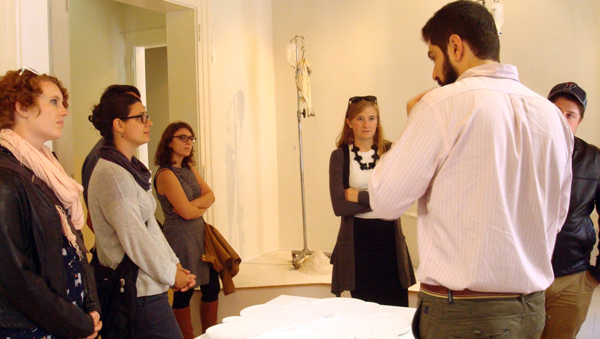
In autumn 2015, U.S. students were guided around to central neighborhood of Psiri starting out from the Varvakios Agora, the colorful and busy central food market of Athens. With appetites opened, we first headed to Klimataria, a traditional Greek tavern just below the Agora, for a lunch break with typical Greek dishes. The ensuing visits included encounters with two Fulbright alumni of the Salzburg Program for Young Cultural Innovators. We tasted a flavored Greek coffee at the recently opened Museum of Gastronomy and climbed the stairs of Romantso, an incubator for start-up companies within the creative industry and a cultural center.
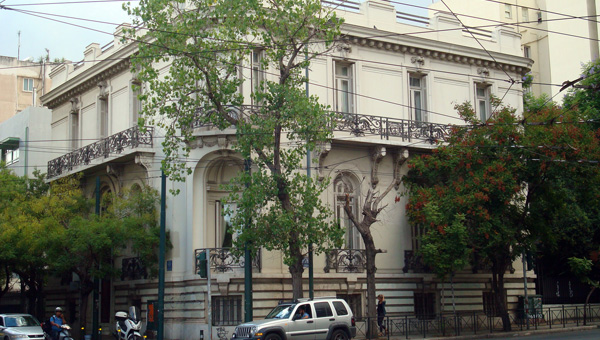
Omonia Square seemed a perfect location to start the 2016 walk for its central role in the development of the city and its moving history. It is one of the oldest squares of Athens, originally situated at the northern edge of the city, and was constructed in 1846. It forms a triangle with Syntagma Square and the Acropolis and functions as a traffic and transport hub with all major central avenues passing though it: Panepistimiou, Athinas, Stadiou, Pireos, Third September and Agiou Konstantinou Streets. Neo-classical buildings can be discovered around such as the four-storied hotels Viktoria/Excelsior (now National Bank of Greece), Bageion and Megas Alexandros, one by one designed by German architect Ernst Ziller who later became a Greek national and received the patronage of King George I himself.
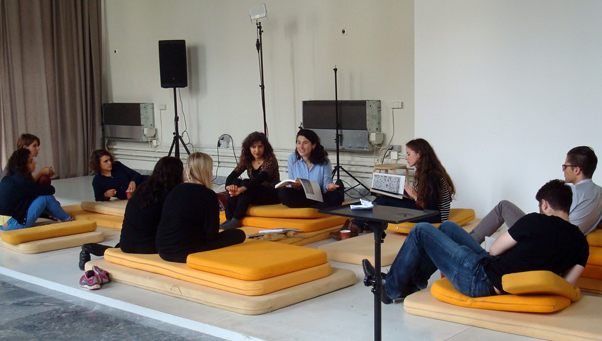
Walking down Patission Street, we were received by the Documenta 14 team, which occupies office space in the Athens School of Fine Arts wing of the Polytechnic School. Documenta tells a long story that started in Kassel, Germany, when it was created in 1955 as an international exhibition of twentieth century art with the aim of bringing Germany back into dialogue with the rest of the world after the end of World War II. For the first time in its history, the current artistic director, Adam Szymczyk, decided to split the events over two countries, Germany and Greece. The Art Walk group met with Education Coordinators, Arnisa Zeqo and Elli Paxinou, and with Documenta artist, Mounira Al Solh (Beirut/Amsterdam) for an informal discussion on art practices.
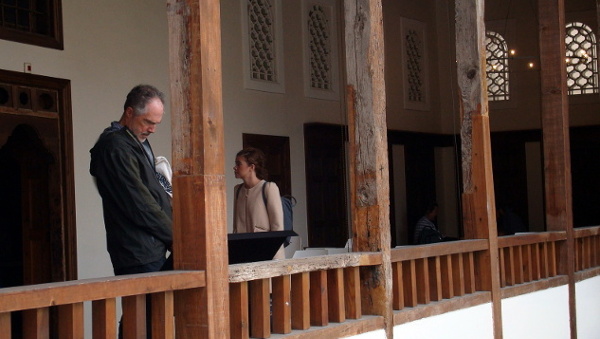
In autumn 2018, we moved on with an Athens Culture Walk to give a taste of private homes in Athens, past and present. From the traditional houses of the Ottoman period to the neoclassical mansions of the 19th century and the ‘polykatoikies’ (multiple homes or apartment buildings) of the 20th, Athens’ buildings witness the city’s rapid expansion from a small town of about 400 houses located at the foot of the Acropolis to its establishment in 1834 as capital of the newly independent state and to the cosmopolitan metropolis it is today. Some of the homes have kept original living arrangements whereas others have been adjusted and given a new life as cultural centers, art spaces, offices or trendy bars and restaurants.
We visited the postwar home of a well-known Greek psychiatrist, viewed the living spaces of an Ottoman period mansion, and visited the museum that tells the history of the city and its nobility.
The Katakouzenos House Museum
The museum is named after Angelos and Leta Katakouzenos, a psychiatrist and his wife who were at the center of cultural life in Athens. The couple belonged to the intellectual elite of their times, and both Angelos and Leto functioned as cultural ambassadors of modern Greece to the rest of the world and as arbiters of international taste to their country. The Katakouzenos house functioned since 1960 as a literary salon; its rooms have hosted many visitors of international fame, mainly artists but also writers and poets; it also contains a representative collection of works by the most important artists of the so-called Greek “1930s generation”, and by many international artists. Following the guided tour, tea will be served on the balcony with a splendid view of the National Gardens.
W http://katakouzenos.gr/en/
A Amalias 4, 105 57 Athens (5th floor)
The Benizelos Family Mansion
In the area of Plaka, at 96 Adrianou Street, behind the tall stone fence is the oldest surviving house in Athens, built in the beginning of the 16th century and renovated at the end of the 17th, the Benizelos Mansion. It is a characteristic two-storied mansion of the period of the Turkish occupation, with a hagiati (roofed verandah) on the floor, arches on the ground floor and an interior yard with a well, spring and olive press. It belonged to Angelos Benizelos, the descendant of an aristocratic family and father of Agia Filothei. Rigoula, as was her name, after her brief marriage and widowhood, became a nun and built a monastery near her house, where today is the Archdiocese of Athens.
W https://www.museeum.com/museum/the-benizelou-mansion/
A Adrianou 96, 10556 Athens
Athens City Museum
The museum carries the name of its founders as the Vouros-Eutaxias Foundation. It was founded in 1973 and opened its doors to the public in 1980. The collections reflect the modern history of the city of Athens since it became the capital of Greece in 1834. The building served as the first royal residence of Greece under the reign of King Otto of Greece and the visitor can still view some of the typical late 19th century- early 20th century sitting and living rooms of the Athenian nobility.
Whttp://www.athenscitymuseum.gr/en/
A Paparrigopoulou 5-7, 10561 Athens

The City Seen Through a Lens was the guideline for the 2019 walk, taking cinema and photography as our starting points. Old movies are a great means to watch past times come alive. The city of Athens during the Twenties, Fifties, Sixties or Eighties is projected on the screen with city views, buildings, people, and styles that have since disappeared. To deeply understand a culture, the visitor needs to understand its roots. Contemporary photographers on the other hand are fascinated with present city life, its inhabitants and dwellings and no media is as direct and honest as photography to capture the spirit of a moment.
The walk took us through some typical Athenian neighborhoods that have only recently been rediscovered such as Kerameikos where the Greek Film Archive and Film Museum is housed in former cinema LAIS. Our visit was enhanced by a 25 minute screening of The Adventures of Villar (1924), the first surviving and restored Greek fiction film. Our next stop was located in the lively area around the Central Market on the fourth floor of an old office building, for which NEON had commissioned Greek photographer Panos Kokkinias to produce an exhibition as portrait of the city entitled Stock Images.
'Stock Images' presents different viewpoints of the city installed within the fabric of the city itself. This contemporary portrait of Athens is presented in an abandoned and disused office space, which has been left largely unchanged since it was last used a decade ago. The area in which it is located has also transformed over time. Often referred to as the ‘commercial triangle’ due to the area’s longstanding relationship with the financial and commercial sector, this part of the city is known for hosting the head offices of several banks, a variety of small businesses, and until recently the Stock Exchange. As is so often the case, change is often abrupt and unpredictable, and the offices, in their current state of disrepair, remind us how quickly things can change, how time takes its toll, and how the modern urban metropolis simultaneously represents optimism for the future as well as failure, fragility and decay. (source: NEON City Projects - Photo credit: Panos Kokkinias)
Greek Film Archive & Film Museum
The Greek Film Archive and Film Museum, better known to the Athenians as the Tainiothiki, used to be housed for years in the neo-classical corner building – the Deligiorgis Mansion - on Akadimias and Kanari Streets in Kolonaki. From there it moved to the Kerameikos neighborhood, to former cinema LAIS, which provides space for the display of a selection of equipment that writes the story of cinematography, an open air cinema on the roof terrace for summer screenings, two screening rooms, a library, an audiovisual reading-room, audiovisual archives and office spaces. The Greek Film Archive also owns storage and restoration premises in the area of Agia Paraskevi, where its own collection of 10,000 titles as well as that of the Greek Film Center is being kept.
W http://www.tainiothiki.gr/en/
A Iera Odos 48 & Megalou Alexandrou Street 134-136, 10435 Athens
Technopolis City of Athens
Technopolis, also simply known as Gazi, has become a hub of cultural events, thus upgrading a historic area of the capital and creating another focal point in the cultural identity of Athens. Gazi refers to the old city gasworks, now restored, as the central stage of the eponymously called neighborhood. A wide variety of cultural events are held in Technopolis every year: music, dance, theatre and performing arts, plastic and applied arts, educational programs for children, entrepreneurship and temporary exhibitions, attracting over 1,000,000 people annually. Part of the city’s industrial heritage, Technopolis is nice to walk into and have a coffee with a view over its brick and iron welded roofs.
W https://athens-technopolis.gr/index.php/en/
A Pireos Street 100, 11854 Gazi, Athens
Municipal Gallery of Athens – Metaxourgeio building
The former factory that now hosts the exhibitions of the Athens Municipal Gallery was designed in 1833 by Danish architect Christian Hansen, becoming one of the oldest neoclassical buildings of modern Athens. In 1852, the building was purchased by an Austrian company to become the first steam silk plant but never went into operation due to bankruptcy. In 1854, the building functioned as a hospital while in that same year the company Siriki Greece was founded – to work as a Metaxourgeio (silk factory) from 1855 until 1875 – becoming the largest unit in Greece and the Balkans. In 1875, the introduction of silk imports from China forced the operation to close down but by then the factory had lent its identity to the city area.
W https://www.gtp.gr/TDirectoryDetails.asp?ID=4448
A Leonidou & Myllerou Streets, 10436 Athens
Municipal Gallery of Athens
The permanent collection and the administration of the Athens Municipal Gallery of Athens are housed in a renovated two-storied neoclassical building on Koumoundourou Square, built in 1874 following the plans of architect Panagis Kalkos for a Municipal Nursery. The inauguration of the Gallery took place on September 22, 1982. The Municipality of Athens began putting together its artist collection in 1923 whereas half of the 2,355 works of art which the Gallery counts among its collection were acquired during the period 1930-1940. Almost all Greek artists whose creations marked the history of Greek art and who contributed to its development in the 20th century are represented in the collection. Among its most interesting features are the collection of engravings, the full representation of the generation of artists of the '30s; the collection of works by the famous architect, Ziller, which are of artistic and historical interest, and among which are 56 drawings of the National Theatre, the Municipal Theatre, as well as of private homes.
W http://www.athensinfoguide.com/wtsmuseums/municipalgallery.htm
A Pireos Street 51, 10553 Koumoundourou Square, Athens
Celebrating the 10th anniversary since the start of the initiative and following a 3-year hiatus due to the pandemic, Fulbright Greece put the annual Athens Culture Walk for incoming U.S. grantees back on the agenda as part of the arrival orientation. The aim is to explore lesser known parts of the City of Athens, focusing on its history, society and culture. In fall 2023, the group visited the up-and-coming neighborhood of Kypseli, centrally located on the northern side of the city. Once upper-class, now working class, Kypseli is an intriguing hybrid of old-time Athenians, immigrants, and young creative professionals, known and loved for its eclectic architecture, lovely squares, and multicultural vibe. One the main attractions of the walk was the large municipal and renovated park at Pedion tou Areos (Field of Ares/Champ de Mars) with the historical Green Park café at its center and with its many references to the Greek Revolution including the American Philhellenes.
Other highlights included a coffee break on the popular pedestrian Fokionos Negri Street, combined with visits to the Meteoritis bookstore and the Kypseli Central Market. The walk ended symbolically on Amerikis Square via architectural landmarks such as the Megaron Metaxa (Metaxas mansion) and the Pyrgos Typaldou (Typaldou tower).
Keep Walking! – a few suggestions
There are numerous activities in the city, many of them on the ‘alternative’ side. Young people undertake initiatives in neighborhoods in the city center that have been abandoned or that are getting ‘ghetto-ized’ in the hope of reviving them. A good meeting point where you will hear about the latest developments is BIOS, a cultural hub with a bar, performance spaces, screenings, concerts, and more.
NEON is a non-profit organization, founded by entrepreneur and private collector Dimitris Daskalopoulos. It is committed to broadening the appreciation, understanding, and creation of contemporary art in Greece in the firm belief that this is a key tool for growth and development. NEON realizes its mission through free exhibitions in collaboration with cultural institutions and supports the program of public and private institutions to enhance increased access and inventive interaction with contemporary art.
locus athens is an independent contemporary arts organization based in Athens. Its program revolves around its interest in the public sphere: from forgotten spaces and public buildings, to small private institutions and interesting localities – in dialogue always with the transformational potential of contemporary art. Just some of the places that have been activated by locus athens in recent years are the Tzisdaraki mosque in central Athens, the cruise ship terminal in Piraeus port, schools, office buildings, Monastiraki square, and the Doxiadis Schools. In 2019, locus athens opened a physical space in the Tavros neighborhood: www.tavros.space
THE FIRST CEMETERY was the first official cemetery of modern-day Greece to be built in Athens in 1837. It contains three churches and the graves and tombs of famous Greek and foreign politicians and intellectuals a.o. Richard Church, Jules Dassin, Odysseas Elytis, Adolf Furtwängler, Humphrey Jennings, Theodoros Kolokotronis, Melina Mercouri, Dimitri Mitropoulos, Kostis Palamas, Alexandros Panagoulis, Andreas Papandreou, Katina Paxinou, Giorgos Seferis, Charilaos Trikoupis, T.H. White, Ernst Ziller. The cemetery is a peaceful spot in the city with many plants and trees, resembling a garden. Its collection of nineteenth- and twentieth-century funerary monuments contains excellent examples of Neoclassical sculpture e.g. the Sleeping Maiden by Giannoulis Chalepas, and the tombs of businessman and philanthropist, Georgios Averoff, and German archeologist, Heinrich Schliemann.
The Julia & Alexander N. DIOMEDES Botanic Garden in the western suburb of Haidari is the product of a donation and long-term thinking by late Greek academic, politician and prime-minister Alexander N. Diomedes (1875-1950). If you like visiting urban parks and other public spaces this is something to put in your agenda, even though it will be a bit of a journey. The botanical garden and adjoining wood (186 hectares in total) are maintained and run through funding from Diomedes' trust fund, with the care of the University of Athens, as a public benefit foundation. The latest project involves the establishment of a new section hosting all the endemic, rare and endangered plant species of the Greek flora. An important contribution of the Garden Institute is the awareness of the public to subjects as the conservation of the environment, the protection of rare and endangered species etc.
CONTEMPORARY GREEK ART INSTITUTE (ISET) is a good place to start if you are interested in contemporary Greek art and culture. Set up as an archive, ISET is a research organization dedicated to the systematic documentation of visual arts’ related activities in Greece from 1945 to date.
The Athens Art Walk was initiated by Els Hanappe, Greek Program Coordinator at the Fulbright Foundation in Greece.
Brief Resume
Els Hanappe studied Art History at the University of Gent in Belgium, specializing in contemporary art through exhibition practice and hands-on experience. She has organized and hosted numerous solo and group shows in her own privately owned galleries, Els Hanappe Underground and SIAKOS.HANAPPE House of Art, and through ITYS, a private non-profit initiative based on a private collection. For 8 years she acted as collection manager for the ITYS Collection.
If there wasn't anything to find out, it would be dull (Mark Twain) - Discover 12 small museums
1. The Jewish Museum of Greece
The idea of building a Jewish Museum of Greece was first conceived in the 1970’s by members of the Jewish Community of Athens, who offered every kind of assistance towards the realization of this dream. The Museum was first established in 1977 and housed in a small room next to the city’s synagogue. It housed objects salvaged from WW II, whether artefacts, documents and manuscripts of the 19th and 20th centuries, or the jewelry of the Jews of Thrace that had been seized by the Bulgarians in 1943. As a historical and ethnographical museum its main interest is to provide a vivid picture of Jewish life and culture as it was during 2,300 years of Jewish life in Greece. The collection contains more than ten thousand artefacts (some of which are unique) pertaining to the domestic and religious life, as well as the history of the Greek Jews. The new building of the Museum houses its rich collection and visitor services in an area of 800 m2, organized in permanent exhibition areas with thematic modular exhibits, an art gallery, a periodic exhibition space, a research library, a space for educational programs, a photo archive and laboratory and a conservation laboratory.
W www.jewishmuseum.gr
A Nikis 39, Syntagma Square
2. Museum of Greek Folk Art
The Museum of Greek Folk Art was founded in 1918 by the poet Georgios Drosinis, the archaeologist G. Kourouniotis and a group of Athenian intellectuals under the name "Museum of Greek Handicrafts". In 1923 its name was changed to "National Museum of Decorative Arts". It was given its present name in 1959. Until 1973 the Museum was housed in the Tzistaraki Mosque in Monastiraki Square. The permanent exhibition – containing representative examples of every branch of every branch of modern Greek Folk Art – give prominence to the features that formed the cultural identity of modern Greeks in the period from 17th to the beginning of the 20th c. The collections contain outstanding examples of embroidery, weaving, traditional costumes, masquerades, the shadow theatre, silverware, metalwork, pottery, wood carving, folk painting and stone carving. The Museum of Greek Folk art also comprises the Mosque of Tzisdarakis or Mosque of the Lower Fountain, the Bath House of the winds, the Greek Folk Music Instruments Museum, and the Museum on 22 Panos Street for Man & Tools.
W www.melt.gr
A Kydathinaion 17, Plaka
3. Centre of Folk Art and Tradition
The museum is housed in the former residence of the great folklorist Angeliki Hatzimichali (1895-1965), who grew up in Plaka. The building is the work of Macedonian architect Aristotelis Zachos, a notable researcher of Greek tradition. Its attractive interior was created by folk art craftsmen. Today it falls under the authority of the City of Athens Cultural Organisation. Exhibits in the neoclassical family mansion of Angeliki Hatzimichali include detailed costumes, ceramic plates from Skyros, handwoven fabrics and embroideries, and family portraits. A folkloric art library comprising books and magazines on ethnography, folk art, tradition and literature, mostly concerning Greece and the Balkans, operates on the premises. The library does not lend out books but has a reading room and provides printouts of its publications.
W www.cityofathens.gr/en/centre-folk-art-and-tradition-0
A Angelikis Hatzimichalis 6, Plaka
4. Ilias Lalaounis Jewelry Museum
The Ilias Lalaounis Jewelry Museum is a unique museum devoted to the art of jewelry and the decorative arts. The museum was founded in 1993 and opened to the public, as a non-profit organisation. Today the Museum’s permanent collection includes over 4000 pieces of jewelry and micro sculptures from over 50 collections designed by the museum’s founder, Ilias Lalaounis, between 1940 and 2000. The works of jewelry and microscupltures displayed are only few from over 17.000 works made by the master jewellers of Lalaounis’ workshop and they are organised in 6 sections within the galleries: “The Golden Dawn Of Art”, “The History of Ancient Greek Art”, “Jewelry Inspired From Other Civilizations”, “Collections Inspired From Nature”, “Collections Inspired From Space, Biology and Modern Technology”, “Special Commissions and Private Collections”. The permanent collection is further enriched with donations including jewelry and decorative arts from around the world.
W www.lalaounis-jewelrymuseum.gr
A Karyatidon & Kallisperi 12, Acropolis
5. The Athens University History Museum
The Athens University History Museum is located in one of the oldest residential buildings still standing in Athens today. It dates before the 18th century and it is situated beneath the imposing heights of the Acropolis with a panoramic view of Plaka, the Ancient Agora, the Athens Observatory and the Lycabbetus Hill. The historical building was the home of the architect Stamatios Kleanthis and is also known as the ‘Kleanthis House’ or ‘Old University’, since, from 1837 and for four years, it functioned as the first University of the independent Greek state. The Athens University History Museum was inaugurated in 1987, in the context of the celebrations for the 150th Anniversary of the University of Athens. The principal aims of the Museum are the collection, preservation, study, conservation and presentation of the University’s historical memorabilia and the organization of cultural events. The Museum illustrates much more than the history of the University, and constitutes an important guide to modern Greek history. The permanent exhibition includes items which are presented thematically and pertain to the schools of medicine, law, philosophy and theology.
NOTE The University of Athens has another 15 museums, the Museum of Mineralogy and Petrography, the Museum of Anthropology, Zoological Museum, Geology and Paleontology, the museum of facial evolution and the history of dentistry, The other 13 museums are dedicated to anatomy, archaeology and history of art, biblical and Christian archaeology, botany, paleontology and geology, crime, zoology, the history of education, pharmacology, natural sciences and technology and, finally, the history of the university itself. Most are located in the buildings housing the relevant departments and are visited mostly by students and school groups. Others are in buildings owned by the institution in other parts of the city, as well as in the university’s big campus in the suburb of Zografou.
A Tholou 5, Plaka
6. Institute of study of Greek Contemporary Ceramic Art
The goal of the Institute of study of Greek Contemporary Ceramic Art is to study, preserve and present the ceramic Greek art mostly of the 19th century. He institute is located in an old neoclassical building that used to be the house of the family Petropoulou. The house was built in 1875 and functioned as a private home until 1969. In that year the Archaeological Institute took over the house and started using it as office space. In 1999 the restoration of the building was completed and was offered to the Institute of study of Greek Contemporary Ceramic Art. The collection of the Institute of study of Greek Contemporary Ceramic Art includes over 5000 ceramic objects. The first part of the exhibition contains every-day ceramic objects that come from different areas of Greece such as Minor Asia or the Balkans, the second part is devoted to works of famous ceramic artists. Detailed explanations are provided on the manufacturing and on the various techniques of ceramic art.
A Melidoni 2, Thissio
7. The Exile Museum and Makronissos Museum
The island of Ai-Stratis is located in the Northern Aegean Sea and is inhabited by 220 permanent residents. For a very long period, 1926 to 1967, it became one of the many exile destinations in Greece. It is estimated that over 100.000 exiles were sent off to Ai-Stratis during that period, including men, women and children. The Museum is dedicated to the exile experience which is preserved through artifacts, documents, art work, photographs, newspapers, magazines and original oral history records. A considerable collection of paintings, stone reliefs, engravings, sketches and prints and other valuable objects have come under its shelter. In recent years, the museum collections have been enriched by documents referring to the prison and concentration camp experience in Greece as well as that of political refugees.
Following the Civil War (1946-49), many of the detainees on Ai-Stratis were moved to the new concentration camps on the island of Makronissos.
W www.exile-museum.gr
A Agion Asomaton 31, Thissio
8. The Institute of Hellenic Mills
The Institute of Hellenic Mills is a non-profit organization established for the purposes of study, research, documentation, and protection of historical forms of mills, as well as related traditional systems of energy sources in the Greek territory. Its specific aims are: formation of archives within a documentation center; specialization of scientific and technical personnel; and the creation of a Museum of Molinological History in Greece. The term “mill” designates its various forms, as being classified according to aspects like: source of driving force (hand-mill, animal- or human-driven mill, windmill, watermill, etc.), final product (flour mill, rice mill, gunpowder mill, oil-mill, tanning mill etc.), mechanical function (compression, hulling, sawing, grinding, crushing, etc.) and includes all those elements that constitute its physical surroundings. Being a member of The International Molinological Society (T.I.M.S.), the Institute of Hellenic Mills was established in Athens in 1996. Its regular members include architects, archaeologists, historians, ethnologists, folklorists, engineers, restorers, lawyers, economists, researchers, mill owners, local authorities etc.
A Agion Asomaton 45
9. Epigraphical Museum
Although the Epigraphical Museum is a unique place and the third-largest museum of ancient inscriptions in the world, more often than not it gets overlooked by visitors to the adjoining National Archaeological Museum. Its collection comprises about 13,500 inscriptions ranging from the eighth century BC to the Late Roman period, with the exception of a few examples which date to the Byzantine and Modern era. It is situated in the south wing of the National Archaeological Museum of Athens. Four of its rooms are accessible to visitors, while the rest is reserved for researchers. The inscriptions in the permanent collection of the Epigraphical Museum are, mostly, Greek. There are also some Latin as well as some byzantine and post byzantine inscriptions and a small number of Hebrew funerary inscriptions of the sixteenth-seventeenth centuries from Mystra (Laconia). Most of the inscriptions are carved on stone or marble, but there are also stamped amphora handles and inscribed clay roof-tiles.
A Tositsa 1, Athens
10. Goulandris Natural History Museum
In the north of the city, in the suburb of Kifissia, Angelos and Niki Goulandris founded in 1964 the Goulandris Natural History Museum as a workshop for action and research on the country’s natural (biological and geological) wealth. The research and investigation of Greek nature has revealed the biodiversity and incomparable beauty of the Greek landscape. Greece is of particular interest because of its geomorphology, its climate and its geographical position at the juncture of three continents. In proportion to its size, it has the greatest biodiversity among European countries, as well as a high percentage of endemic species. The Museum first opened with the aim to collect, study and record the Greek flora. In 1977 it was expanded to cover the fields of zoology, palaeontology and geology. In 1991 it founded the Greek Biotope/Wetland Centre (EKBY) to help avert and reverse the loss and degradation of wetlands and terrestrial natural ecosystems, primarily in and also in the rest of the Mediterranean region. Looking forward to the 21st Century and in view of the continuing environmental degradation, the Museum has undertaken to create the GAIA Centre for Environmental Research and Education, conceived as a pioneering center of scientific research and education, which will contribute to the establishment of a new environmental policy in Greece, in Europe and internationally.
W www.gnhm.gr
A Levidou 13, Kifissa
11. Industrial Gas Museum
The Industrial Gas Museum is located on a listed and preserved historical site also known as ‘Technopolis’ or the ‘Gazi’. The Athens gasworks was established in 1857, just three years after the Douroutis silk mill, in order to cover the city's need for public lighting. These were Athens's first two industrial plants, which marked the city's town-planning and financial development. The gasworks was the first energy production unit in all of Greece. Its key location at the beginning of Pireos Street served to spur further growth, rendering Pireos Street the city's largest industrial zone for several decades. Following a carefully drawn museological pathway with specified stops along its course, visitors have the opportunity to tour the plant's facilities, observe the coal gas production line and discover a so far "forgotten" part of the history of Athens. At the same time, topics such as industrial heritage and industrial archaeology, entrepreneurship, industrial working conditions at the plant, old and new forms of energy, unfold before the visitors' eyes through original objects and equipment, numerous photographs, audio testimonials and video projections. Technopolis City of Athens has become a hub of cultural events: music, dance, theatre and performing arts, plastic and applied arts, educational programs for children, entrepreneurship and temporary exhibitions. Furthermore, its opening has upgraded the whole neighborhood around it, which has now become a lively area with numerous cafes, restaurants, and theaters.
W https://athens-technopolis.gr/index.php/en/igm
A Pireos & Anthimou Gazi 100, Athens
12. Museum of Wax
A little known but extraordinary museum is the Andreas Syggros Museum, located on the premises of the Andreas Syggros Hospital of Cutaneous & Venereal Diseases, behind the Athens Hilton. The museum contains 16660 wax models / pastes / preforms of aphrodisiac and dermatological diseases, which were manufactured / fabricated/ constructed by G. O. Foteinos and by trained technicians. Whilst being in Paris for studies (1902-1905), G. O. Foteinos trained himself in the manufacturing of preforms, having understood the major importance of the visual image and of memory in the education of Dermatology and Aphrodisiology. The preforms were executed with great exactitude in collaboration with the University Clinic of Berlin.
A Ι. Dragoumi 5, Αthens
The information contained in this website is for general information purposes only. The information is provided by the Fulbright Foundation Greece. While we endeavor to keep the information up-to-date and correct, we make no representations or guaranties of any kind, expressly or implied, about the completeness, accuracy, reliability, suitability, or availability with respect to the website or the information, services, or related graphics contained on the website for any purpose. Any reliance you place on such information is therefore strictly at your own risk.
Through this website you are able to link to other websites that are not under the control of the Fulbright Foundation Greece. We have no control over the nature, content, and availability of those sites. The inclusion of any links does not imply a recommendation or endorsement of the views expressed within them.

